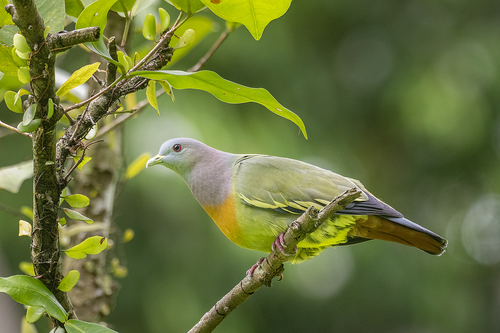
Pink-necked Green Pigeon
The Pink-necked Green Pigeon (Treron vernans) is a vibrant and visually striking bird species found across Southeast Asia. Known for its distinctive coloration, with males sporting a bright pink neck and upper breast, this pigeon plays a crucial role in seed dispersal within its tropical forest habitat. It is a relatively common sight in its range, often observed in small flocks feeding on fruits and berries. It is not considered globally threatened, highlighting its adaptability to a variety of forest environments, including secondary growth and edges.
25-30 cm
Length
Unknown cm
Wingspan
Least Concern
Conservation Status
Distribution
Southeast Asia, including Thailand, Malaysia, Singapore, Indonesia (Sumatra, Java, Borneo, Sulawesi, and smaller islands), and parts of the Philippines. It is typically a lowland species, rarely found above 1200m altitude.
Lifespan
Unknown in the wild; likely several years, similar to other pigeons of comparable size.
Pink-necked Green Pigeon's Habitat
Habitat Types
Tropical rainforests, Mangrove forests, Secondary forests, Woodland edges, Parks and gardens (in some areas)
Climate Zones
Tropical
Adaptations
Their strong gizzards allow them to process hard seeds, contributing to effective seed dispersal. Their relatively small size and agility enable them to navigate dense forest vegetation.
Variations
There are no widely recognized subspecies, although slight variations in plumage color and size may occur across its range.
Appearance
Breeding Plumage
Minimal difference; breeding males may have slightly brighter coloration.
Seasonal Feather Changes
None
Sex Based Plumage Differences
Significant. Males have a pink neck and upper breast, orange lower breast, and grey head. Females are generally greener, lacking the pink and orange coloration.
Notable Features
Bright pink neck and upper breast (males), Orange lower breast (males), Green wings and back, Greyish-blue head (males)
Diet and Feeding
Primary Foods
Fruits, Berries, Figs
Foraging Behavior
Forages primarily in the canopy and mid-story of trees, often in small flocks. They are agile climbers and can hang upside down to reach fruit.
Specializations
Strong gizzard for processing hard seeds. Adaptable to a wide variety of fruit types.
Seasonal Diet Variations
Diet may shift slightly depending on fruit availability in different seasons, but largely frugivorous year-round.
Behavior
Social Structure
Typically found in pairs or small flocks, sometimes congregating in larger groups at fruiting trees.
Communication
Soft cooing vocalizations, Bowing displays during courtship
Migration
Generally non-migratory; some local movements may occur in response to food availability.
Territorial or Group Behaviors
Not strongly territorial; often feeds in mixed-species flocks with other frugivorous birds.
Conservation
Threats
Habitat loss (deforestation for agriculture and development), Hunting (in some areas)
Protection Programs
General habitat protection measures in some protected areas within its range.
Local National Laws
Protected under general wildlife laws in many countries within its range, but enforcement may vary.
Population Trend
Stable
Population Estimates
Not Evaluated, but considered relatively common in suitable habitat.
Interesting Facts
They are important seed dispersers.
By consuming fruits and excreting the seeds in different locations, they help maintain forest diversity.
Both male and female pigeons produce crop milk.
This nutritious substance is fed to the young chicks, similar to how mammals produce milk.
They can be surprisingly inconspicuous despite their bright colors.
Their green plumage provides excellent camouflage in the forest canopy.
Faqs about Pink-necked Green Pigeon
What is the main difference between male and female Pink-necked Green Pigeons?
Males have a distinctive pink neck and orange breast, while females are predominantly green.
Are they endangered?
No, they are classified as Least Concern by the IUCN.
What do they eat?
They primarily eat fruits and berries.
Where do they live?
They live in Southeast Asia, including Thailand, Malaysia, Singapore, Indonesia and the Phillipines.
Copyright @ Nature Style Limited. All Rights Reserved.
 English
English